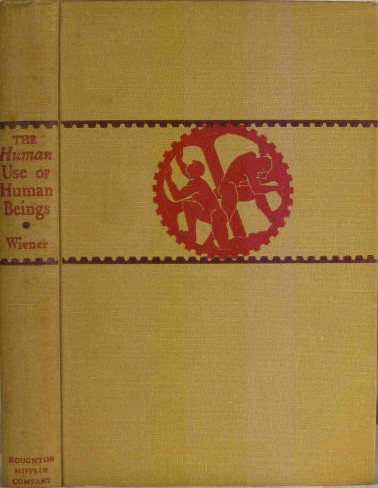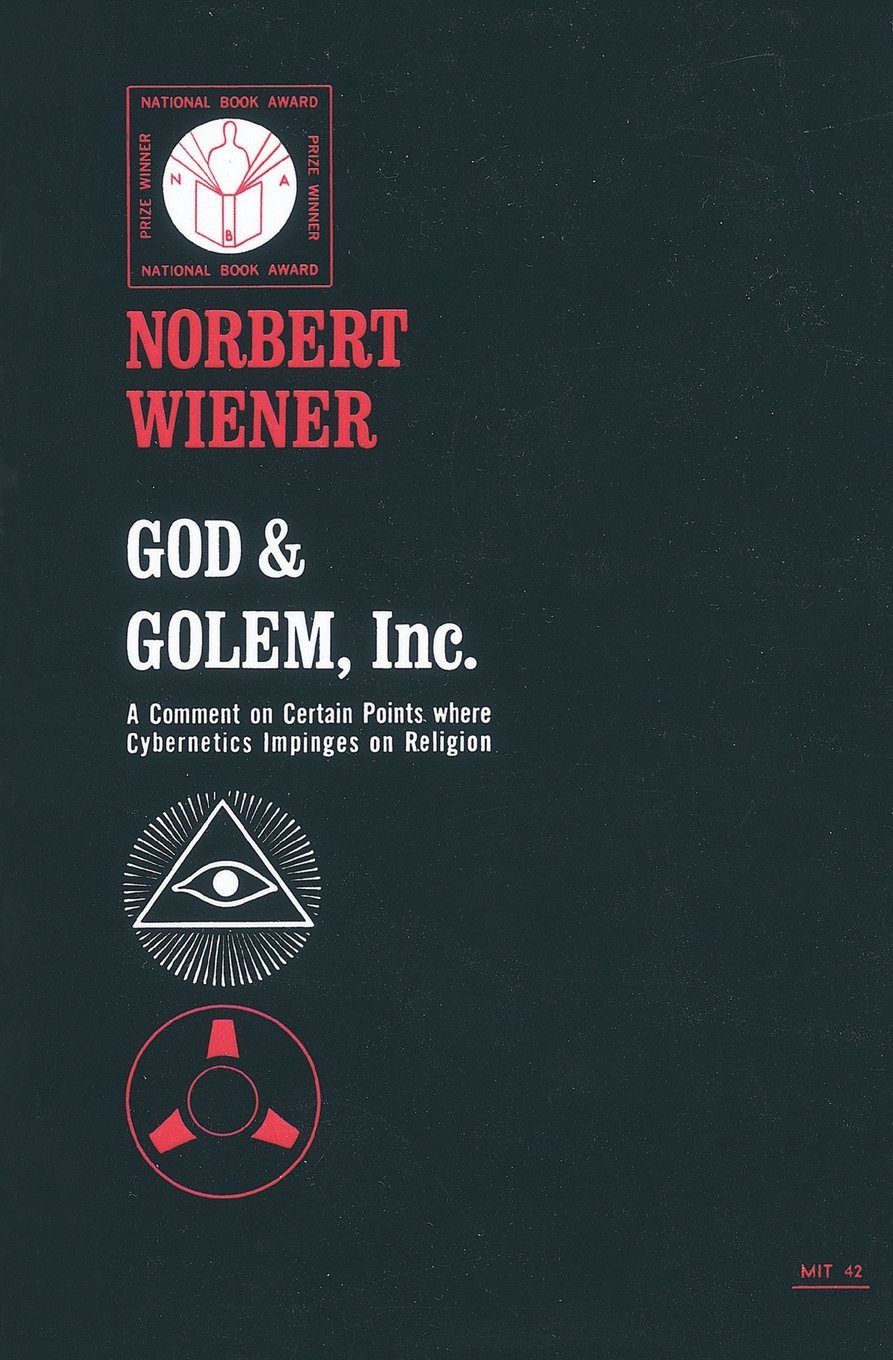Norbert Wiener: The Human Use of Human Beings: Cybernetics and Society (1950–) [EN, FR, BR-PT, RU, ES, SC, IT, GR]
Filed under book | Tags: · computing, cybernetics, entropy, machine, society, theory of communication

“Founder of the science of cybernetics—the study of the relationship between computers and the human nervous system—Wiener was widely misunderstood as one who advocated the automation of human life. As this book reveals, his vision was much more complex and interesting. He hoped that machines would release people from relentless and repetitive drudgery in order to achieve more creative pursuits. At the same time he realized the danger of dehumanizing and displacement. His book examines the implications of cybernetics for education, law, language, science, technology, as he anticipates the enormous impact—in effect, a third industrial revolution—that the computer has had on our lives.”
Publisher Houghton Mifflin, Boston, 1950
241 pages
New edition
With an Introduction by Steve J. Heims
Published by Free Association Books, London, 1989
ISBN 1853430757
xxx+199 pages
Wikipedia (EN)
The Human Use of Human Beings: Cybernetics and Society (English, 1950, added on 2021-4-8)
The Human Use of Human Beings: Cybernetics and Society (English, 1950/1989, updated on 2021-4-8)
Cybernétique et société: l’usage humain des êtres humains (French, 1952/2014, EPUB, added on 2021-4-8)
Cibernética e sociedade: o uso humano de seres humanos (BR-Portuguese, trans. José Paulo Paes, 2nd ed., 1954/1968, added on 2013-12-12)
Kibernetika i obshchestvo (Russian, trans. E.G. Panfilov, 1958, DJVU, added on 2021-4-8)
Cybernética y sociedad (Spanish, trans. José Novo Cerro, 1958, added on 2021-4-8)
Kibernetika i društvo: ljudska upotreba ljudskih bića (Serbo-Croatian, trans. Ljubomir Radanović, 1964, added on 2021-4-8)
Introduzione alla cibernetica: l’uso umano degli esseri umani (Italian, trans. Dario Persiani, 1966, added on 2021-4-8)
Kyvernētikē kai koinōnia: ē anthrōpinē chrēsimopoiēsē tōn anthrōpinōn ontōn (Greek, trans. Giannē Iōannidē, 1970, DJVU, added on 2021-4-8)
John Johnston: The Allure of Machinic Life. Cybernetics, Artificial Life, and the New AI (2008)
Filed under book | Tags: · abstract machine, artificial intelligence, artificial life, cellular automata, connectionism, cybernetics, genetic algorithms, robotics, swarm intelligence

“In The Allure of Machinic Life, John Johnston examines new forms of nascent life that emerge through technical interactions within human-constructed environments—”machinic life”—in the sciences of cybernetics, artificial life, and artificial intelligence. With the development of such research initiatives as the evolution of digital organisms, computer immune systems, artificial protocells, evolutionary robotics, and swarm systems, Johnston argues, machinic life has achieved a complexity and autonomy worthy of study in its own right.
Drawing on the publications of scientists as well as a range of work in contemporary philosophy and cultural theory, but always with the primary focus on the “objects at hand”—the machines, programs, and processes that constitute machinic life—Johnston shows how they come about, how they operate, and how they are already changing. This understanding is a necessary first step, he further argues, that must precede speculation about the meaning and cultural implications of these new forms of life.
Developing the concept of the “computational assemblage” (a machine and its associated discourse) as a framework to identify both resemblances and differences in form and function, Johnston offers a conceptual history of each of the three sciences. He considers the new theory of machines proposed by cybernetics from several perspectives, including Lacanian psychoanalysis and “machinic philosophy.” He examines the history of the new science of artificial life and its relation to theories of evolution, emergence, and complex adaptive systems (as illustrated by a series of experiments carried out on various software platforms). He describes the history of artificial intelligence as a series of unfolding conceptual conflicts—decodings and recodings—leading to a “new AI” that is strongly influenced by artificial life. Finally, in examining the role played by neuroscience in several contemporary research initiatives, he shows how further success in the building of intelligent machines will most likely result from progress in our understanding of how the human brain actually works.”
Publisher MIT Press, 2008
ISBN 0262101262, 9780262101264
461 pages
PDF (updated on 2012-10-31)
Comment (0)Norbert Wiener: God and Golem, Inc.: A Comment on Certain Points Where Cybernetics Impinges on Religion (1964–) [EN, RU, ES, RO]
Filed under book | Tags: · cybernetics, mathematics, religion, science

“In this book, Norbert Wiener concerns himself with major points in cybernetics which are relevant to religious issues.
The first point he considers is that of the machine which learns. While learning is a property almost exclusively ascribed to the self-conscious living system, a computer now exists which not only can be programmed to play a game of checkers, but one which can “learn” from its past experience and improve on its own game. For a time, the machine was able to beat its inventor at checkers. “It did win,” writes the author, “and it did learn to win; and the method of its learning was no different in principle from that of the human being who learns to play checkers.
A second point concerns machines which have the capacity to reproduce themselves. It is our commonly held belief that God made man in his own image. The propagation of the race may also be interpreted as a function in which one living being makes another in its own image. But the author demonstrates that man has made machines which are “very well able to make other machines in their own image,” and these machine images are not merely pictorial representations but operative images. Can we then say: God is to Golem as man is to Machines? in Jewish legend, golem is an embryo Adam, shapeless and not fully created, hence a monster, an automation.
The third point considered is that of the relation between man and machine. The concern here is ethical. “render unto man the things which are man’s and unto the computer the things which are the computer’s,” warns the author. In this section of the book, Dr. Wiener considers systems involving elements of man and machine.
The book is written for the intellectually alert public and does not involve any highly technical knowledge. It is based on lectures given at Yale, at the Société Philosophique de Royaumont, and elsewhere.”
Publisher MIT Press, 1964
ISBN 0262730111, 9780262730112
ix+95 pages
God and Golem (English, 1964, updated on 2021-4-8)
Tvorets i robot (Russian, trans. M.N. Aronz and R.A. Fesenko, 1966, DJVU, added on 2021-4-8)
Dios y Golem (Spanish, trans. Javier Alejo, 1967, EPUB, added on 2021-4-8)
Dumnezeu şi Golem (Romanian, trans. Edmond Nicolau and Lucia Nasta, 1969, added on 2021-4-8)

